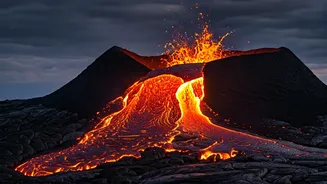Volcanoes Unveiled
Volcanoes are more than just mountains; they are dynamic vents in the Earth's crust where molten rock, ash, and gases erupt to the surface. Their formation
is a result of the Earth's tectonic plates shifting and colliding, which generates intense heat and pressure that melts rock deep within the planet. The molten rock, known as magma, rises to the surface through weaknesses in the Earth's crust, leading to eruptions. The intensity and type of eruption depend on several factors, including the magma's composition, gas content, and the surrounding geological environment. Volcanoes play a crucial role in shaping the Earth's surface, building new landmasses, and influencing the climate through the release of gases and particles into the atmosphere. Studying active volcanoes helps scientists understand these processes and assess potential hazards posed by future eruptions. They represent a significant geological force.
Kilauea, Hawaii
Kilauea, located in Hawaii, is renowned for its nearly continuous eruptions and its dramatic displays of lava flows. This shield volcano, known for its gently sloping sides, is one of the most active volcanoes globally. Kilauea's eruptions are primarily effusive, meaning that the lava flows smoothly and steadily, creating stunning rivers of molten rock that cascade down the volcano's slopes. The lava is relatively low in silica, which allows it to flow easily, creating vast lava fields and shaping the landscape over time. Despite its relatively gentle eruptions, Kilauea's activity has profoundly impacted the surrounding environment, creating new land and destroying property. This volcano has a rich history of eruptive activity and it continues to provide scientists with invaluable data about volcanic processes. Its ongoing activity makes it a vital site for research and monitoring.
Mount Etna, Italy
Mount Etna, situated on the island of Sicily, Italy, is Europe's most active volcano and one of the world's most frequently erupting volcanoes. Etna's eruptions vary in style, from effusive lava flows to explosive eruptions that can send ash and volcanic debris high into the atmosphere. Its frequent activity has made it a central part of Sicilian life, influencing agriculture, tourism, and even cultural traditions. The fertile volcanic soil around Etna supports abundant plant life, including vineyards and orchards, making the area renowned for its agricultural productivity. The volcano's slopes are also home to numerous villages and towns, some of which have been impacted by eruptions over the centuries. Scientists closely monitor Etna's activity to mitigate the risk to nearby communities and understand the complex volcanic processes. Its impressive height and the beauty of its eruptions continue to attract tourists and researchers alike.
Popocatépetl, Mexico
Popocatépetl, often called 'Popo,' is one of Mexico's most active volcanoes and looms large near Mexico City. Its name means 'Smoking Mountain' in the Nahuatl language, reflecting its frequent activity and the plumes of smoke and ash it emits. Popocatépetl is a stratovolcano, characterized by steep sides and explosive eruptions that can pose significant hazards to nearby communities. The volcano is continuously monitored because of the significant population living in its vicinity. Eruptions from Popocatépetl have the potential to disrupt air travel, impact agriculture, and threaten local communities with ashfall and pyroclastic flows. Scientists use a range of techniques, including seismic monitoring, gas analysis, and ground deformation measurements, to track Popocatépetl's activity and issue timely warnings. Regular eruptions have shaped the landscape and instilled a sense of caution among those living around this powerful volcano. The consistent activity of Popocatépetl makes it a key site for volcanological research.
Mount St. Helens, USA
Mount St. Helens, in Washington State, is famously known for its catastrophic eruption in 1980, which dramatically reshaped the landscape. Before 1980, Mount St. Helens was a symmetrical cone-shaped mountain. However, an earthquake triggered a massive landslide and a lateral blast that devastated a vast area. The eruption was one of the most significant volcanic events in recorded U.S. history. Since 1980, Mount St. Helens has been under close observation, with scientists documenting its recovery and studying the processes of ecological succession. The eruption created a unique opportunity for researchers to study the impacts of volcanic activity on ecosystems and observe how life returns to a devastated environment. The lessons learned from Mount St. Helens have improved understanding of volcanic hazards and disaster preparedness. It serves as a living laboratory for the study of volcanic processes and the resilience of natural systems.











